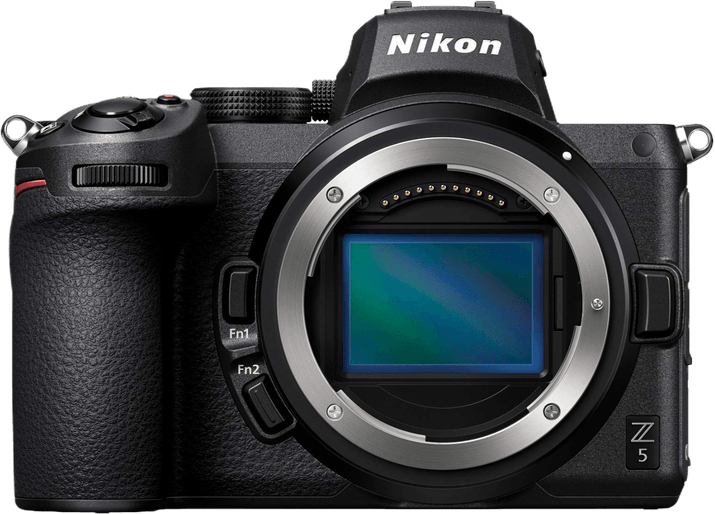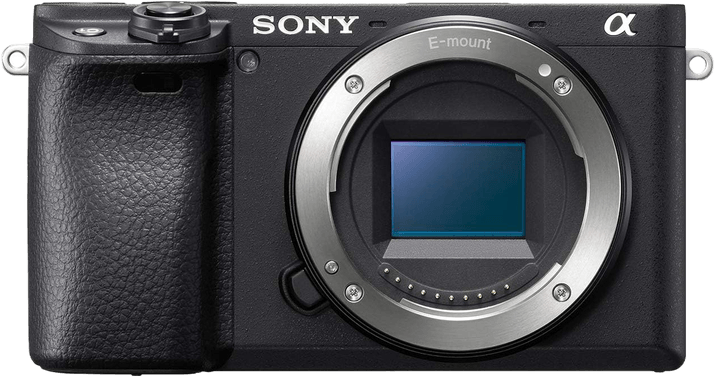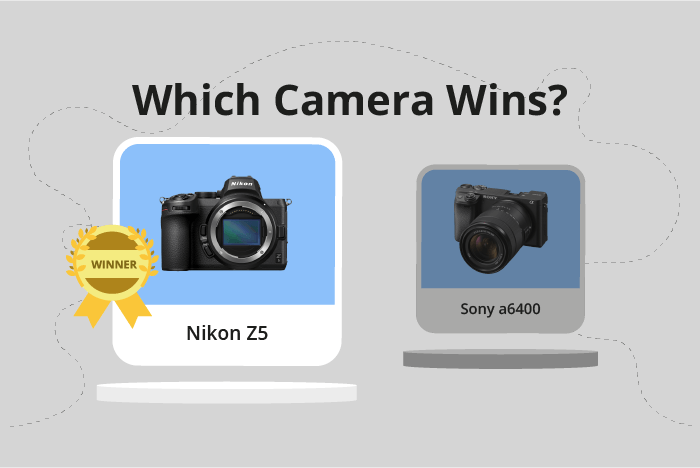Nikon Z5 vs Sony a6400 Comparison
Nikon Z5

Sony a6400

The Nikon Z5 triumphs over the Sony a6400 with a score of 78/100, an 8-point lead from Sony’s 70/100. Both cameras are mirrorless and were released in 2020 and 2019, respectively. They share similarities in camera type and release years, but the Nikon Z5 stands out with its larger size (134 x 100.5 x 69.5mm) and heavier weight (675g / 1.49lbs), which may offer improved ergonomics and build quality.
On the other hand, the Sony a6400 is more compact (120 x 67 x 60mm) and lightweight (403g / 0.89lbs), making it more portable and convenient for travel. However, the Nikon Z5’s higher score reflects its superior performance and features, justifying its higher launch price of $1400 compared to the Sony a6400’s $900.
Weighing the pros and cons of both cameras, the Nikon Z5 emerges as the better choice for those prioritizing performance, while the Sony a6400 caters to users who value portability and affordability.
Nikon Z5 vs Sony a6400 Overview and Optics
The Nikon Z5 wins in the optics comparison with a score of 81/100, while the Sony a6400 scores 68/100. Both cameras have 24-megapixel CMOS sensors and are equipped with advanced processors: the Nikon Z5 with the Expeed 6 and the Sony a6400 with the Bionz X.
The Nikon Z5 excels with its full-frame sensor, which offers a larger sensor size compared to the Sony a6400’s APS-C sensor. This difference results in better image quality, especially in low-light conditions. Additionally, the Nikon Z5 has a higher DXOMARK sensor score of 97, compared to the Sony a6400’s score of 83. The Nikon Z5 also features in-body image stabilization, giving it an advantage in capturing sharp images and smooth video footage.
The Sony a6400, on the other hand, has a faster shooting speed of 11 frames per second, compared to the Nikon Z5’s 4.5 frames per second. This makes the Sony a6400 more suitable for action photography and capturing fast-moving subjects.
Both cameras have their respective lens mounts: the Nikon Z5 with the Nikon Z mount and the Sony a6400 with the Sony E mount. This means that each camera is compatible with a wide range of lenses from their respective manufacturers, offering flexibility and versatility for different photography needs.
The Nikon Z5’s superior sensor size, image stabilization, and higher DXOMARK score make it the better choice for photographers who prioritize image quality and low-light performance. However, the Sony a6400’s faster shooting speed makes it a strong contender for those who need to capture fast-paced action. Ultimately, the choice between these two cameras depends on the photographer’s specific requirements and preferences.
Nikon Z5 vs Sony a6400 Video Performance
The Sony a6400 outperforms the Nikon Z5 in video capabilities, scoring 91/100 compared to the Z5’s 83/100. Both cameras share some common specifications, such as 4K max video resolution and 3840 x 2160 max video dimensions. They also both have built-in time-lapse functionality, making them suitable for capturing dynamic scenes and events.
The Sony a6400 surpasses the Nikon Z5 with a maximum video frame rate of 120fps, while the Z5 only reaches 60fps. This higher frame rate allows the a6400 to capture smoother, more detailed slow-motion footage, making it the better option for videographers who prioritize fluid motion in their videos.
On the other hand, the Nikon Z5 does not have any significant advantages over the Sony a6400 in terms of video capabilities. Both cameras have similar video resolutions and dimensions, and the Z5’s lower frame rate does not offer any benefits. It is important to note that the Nikon Z5 may still excel in other areas, such as image quality or user experience, but in this comparison of video capabilities, it falls short.
Considering the video specifications, the Sony a6400 is the clear winner in this comparison. With a higher video score and a superior maximum frame rate, the a6400 offers better overall video performance. While the Nikon Z5 shares some common specs, it does not outshine the a6400 in any video-related aspect. Videographers and content creators should opt for the Sony a6400 to ensure they capture the best possible footage.
Nikon Z5 vs Sony a6400 Features and Benefits
The Sony a6400 triumphs over the Nikon Z5 in features with a score of 81/100 compared to the Nikon Z5’s 72/100. Both cameras share several specifications, such as a touchscreen, flip screen, and the absence of GPS. Additionally, both cameras have WIFI and bluetooth capabilities.
The Sony a6400 outperforms the Nikon Z5 in certain aspects. Although the screen size is slightly smaller, at 3 inches compared to the Nikon Z5’s 3.2 inches, the a6400’s screen resolution is significantly higher, with 921,600 dots compared to the Z5’s 1,040,000 dots. This difference in resolution allows the a6400’s screen to display sharper and more detailed images, making it easier for users to review their photos and videos.
The Nikon Z5, however, does have some advantages over the Sony a6400. The larger 3.2-inch screen size offers more space for users to navigate menus and review their images. This size difference, though not substantial, can provide a more comfortable viewing experience for some users. However, it is important to note that the Z5’s screen resolution is lower than the a6400’s, which may affect the overall image quality displayed on the screen.
After comparing the features of the Nikon Z5 and the Sony a6400, it is evident that the a6400 is the superior camera in this category due to its higher score and better screen resolution. While the Nikon Z5 has a slightly larger screen, this advantage is not enough to outweigh the benefits of the Sony a6400’s higher resolution and overall feature score.
Nikon Z5 vs Sony a6400 Storage and Battery
The Nikon Z5 outperforms the Sony a6400 in storage and battery with a score of 73/100 against 37/100. Both cameras accept SD, SDHC, and SDXC memory cards, but the Z5 is UHS-II compatible while the a6400 is only UHS-I compatible. Additionally, the Z5 has two memory card slots compared to the a6400’s single slot.
The Nikon Z5 also boasts a longer battery life of 470 shots compared to the Sony a6400’s 410 shots. The Z5 uses an EN-EL15c battery type, while the a6400 uses an NP-FW50 battery. Both cameras offer USB charging capabilities.
Though the Sony a6400 falls short in storage and battery performance, it still provides a decent battery life and USB charging feature, making it a viable option for users with less demanding storage and battery requirements. However, the Nikon Z5’s superior compatibility, dual memory card slots, and longer battery life make it the clear winner in this comparison.
Nikon Z5 vs Sony a6400 – Our Verdict
Are you still undecided about which camera is right for you? Have a look at these popular comparisons that feature the Nikon Z5 or the Sony a6400:

